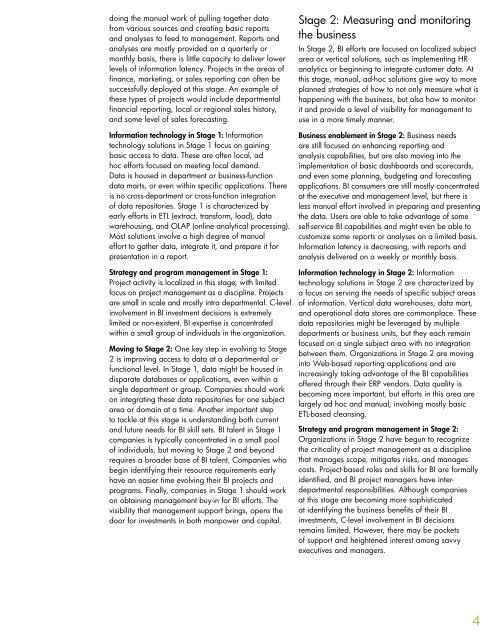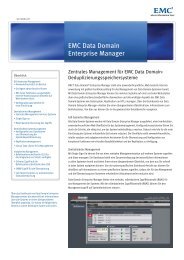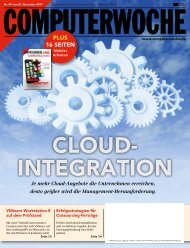The HP Business Intelligence Maturity Model: Describing the BI ...
The HP Business Intelligence Maturity Model: Describing the BI ...
The HP Business Intelligence Maturity Model: Describing the BI ...
Create successful ePaper yourself
Turn your PDF publications into a flip-book with our unique Google optimized e-Paper software.
doing <strong>the</strong> manual work of pulling toge<strong>the</strong>r data<br />
from various sources and creating basic reports<br />
and analyses to feed to management. Reports and<br />
analyses are mostly provided on a quarterly or<br />
monthly basis, <strong>the</strong>re is little capacity to deliver lower<br />
levels of information latency. Projects in <strong>the</strong> areas of<br />
finance, marketing, or sales reporting can often be<br />
successfully deployed at this stage. An example of<br />
<strong>the</strong>se types of projects would include departmental<br />
financial reporting, local or regional sales history,<br />
and some level of sales forecasting.<br />
Information technology in Stage 1: Information<br />
technology solutions in Stage 1 focus on gaining<br />
basic access to data. <strong>The</strong>se are often local, ad<br />
hoc efforts focused on meeting local demand.<br />
Data is housed in department or business-function<br />
data marts, or even within specific applications. <strong>The</strong>re<br />
is no cross-department or cross-function integration<br />
of data repositories. Stage 1 is characterized by<br />
early efforts in ETL (extract, transform, load), data<br />
warehousing, and OLAP (online analytical processing).<br />
Most solutions involve a high degree of manual<br />
effort to ga<strong>the</strong>r data, integrate it, and prepare it for<br />
presentation in a report.<br />
Strategy and program management in Stage 1:<br />
Project activity is localized in this stage, with limited<br />
focus on project management as a discipline. Projects<br />
are small in scale and mostly intra departmental. C-level<br />
involvement in <strong>BI</strong> investment decisions is extremely<br />
limited or non-existent. <strong>BI</strong> expertise is concentrated<br />
within a small group of individuals in <strong>the</strong> organization.<br />
Moving to Stage 2: One key step in evolving to Stage<br />
2 is improving access to data at a departmental or<br />
functional level. In Stage 1, data might be housed in<br />
disparate databases or applications, even within a<br />
single department or group. Companies should work<br />
on integrating <strong>the</strong>se data repositories for one subject<br />
area or domain at a time. Ano<strong>the</strong>r important step<br />
to tackle at this stage is understanding both current<br />
and future needs for <strong>BI</strong> skill sets. <strong>BI</strong> talent in Stage 1<br />
companies is typically concentrated in a small pool<br />
of individuals, but moving to Stage 2 and beyond<br />
requires a broader base of <strong>BI</strong> talent. Companies who<br />
begin identifying <strong>the</strong>ir resource requirements early<br />
have an easier time evolving <strong>the</strong>ir <strong>BI</strong> projects and<br />
programs. Finally, companies in Stage 1 should work<br />
on obtaining management buy-in for <strong>BI</strong> efforts. <strong>The</strong><br />
visibility that management support brings, opens <strong>the</strong><br />
door for investments in both manpower and capital.<br />
Stage 2: Measuring and monitoring<br />
<strong>the</strong> business<br />
In Stage 2, <strong>BI</strong> efforts are focused on localized subject<br />
area or vertical solutions, such as implementing HR<br />
analytics or beginning to integrate customer data. At<br />
this stage, manual, ad-hoc solutions give way to more<br />
planned strategies of how to not only measure what is<br />
happening with <strong>the</strong> business, but also how to monitor<br />
it and provide a level of visibility for management to<br />
use in a more timely manner.<br />
<strong>Business</strong> enablement in Stage 2: <strong>Business</strong> needs<br />
are still focused on enhancing reporting and<br />
analysis capabilities, but are also moving into <strong>the</strong><br />
implementation of basic dashboards and scorecards,<br />
and even some planning, budgeting and forecasting<br />
applications. <strong>BI</strong> consumers are still mostly concentrated<br />
at <strong>the</strong> executive and management level, but <strong>the</strong>re is<br />
less manual effort involved in preparing and presenting<br />
<strong>the</strong> data. Users are able to take advantage of some<br />
self-service <strong>BI</strong> capabilities and might even be able to<br />
customize some reports or analyses on a limited basis.<br />
Information latency is decreasing, with reports and<br />
analysis delivered on a weekly or monthly basis.<br />
Information technology in Stage 2: Information<br />
technology solutions in Stage 2 are characterized by<br />
a focus on serving <strong>the</strong> needs of specific subject areas<br />
of information. Vertical data warehouses, data mart,<br />
and operational data stores are commonplace. <strong>The</strong>se<br />
data repositories might be leveraged by multiple<br />
departments or business units, but <strong>the</strong>y each remain<br />
focused on a single subject area with no integration<br />
between <strong>the</strong>m. Organizations in Stage 2 are moving<br />
into Web-based reporting applications and are<br />
increasingly taking advantage of <strong>the</strong> <strong>BI</strong> capabilities<br />
offered through <strong>the</strong>ir ERP vendors. Data quality is<br />
becoming more important, but efforts in this area are<br />
largely ad hoc and manual, involving mostly basic<br />
ETL-based cleansing.<br />
Strategy and program management in Stage 2:<br />
Organizations in Stage 2 have begun to recognize<br />
<strong>the</strong> criticality of project management as a discipline<br />
that manages scope, mitigates risks, and manages<br />
costs. Project-based roles and skills for <strong>BI</strong> are formally<br />
identified, and <strong>BI</strong> project managers have interdepartmental<br />
responsibilities. Although companies<br />
at this stage are becoming more sophisticated<br />
at identifying <strong>the</strong> business benefits of <strong>the</strong>ir <strong>BI</strong><br />
investments, C-level involvement in <strong>BI</strong> decisions<br />
remains limited. However, <strong>the</strong>re may be pockets<br />
of support and heightened interest among savvy<br />
executives and managers.<br />
4
















